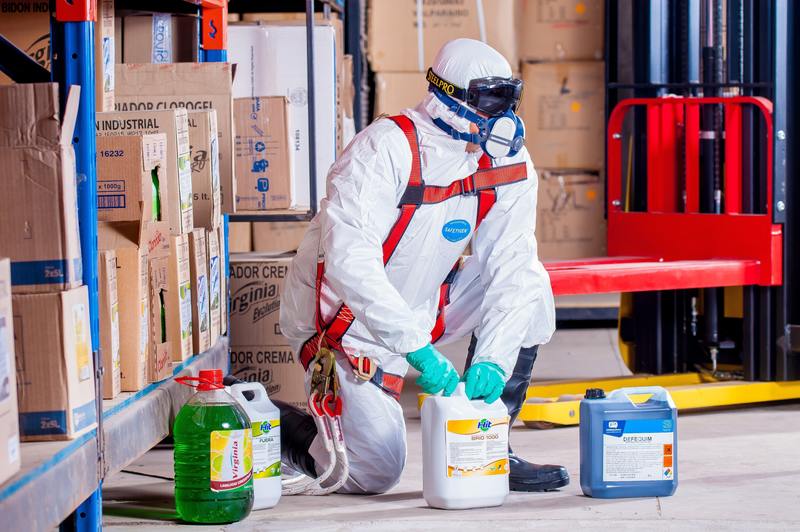What is the right way to store pest control chemicals? A pesticide storage facility that is well-designed and well-maintained is crucial.
Products can be vandalized, stolen, or misused if left unorganized. If you want to learn more about this, here’s what you need to know.

Why Is It Essential To Store Pest Control Materials?
Whether accidental or not, human damage from exposure is crucial for proper storage, which is especially true for children. You can safely secure your area by preventing unintentional chemical spills and achieving property damage by storing chemicals properly.
You should handle pesticides that are poisonous or corrosive with extra care. Though not considered acutely dangerous, even compounds that do not pose an immediate threat to human health can induce fear if used to taint water supplies or food goods, sprinkled overpopulated regions, or otherwise mistreated.
Moreover, ingestion or prolonged skin contact with most pesticides will have harmful consequences, whether on purpose or by accident. While pesticides get in the air, they may include pesticide molecules.
Pollution of surface, food, or soil is another potential danger. Here’s an additional guide on how is pest control done and what are the 3 principles of pest control.
What Is The Right Way To Store Pest Control Chemicals?
1. Create a separate location
There must be a safe distance between pesticide storage facilities and human and animal environments. You should establish a distinct location to store pesticides as a best-case scenario.
If a standalone facility is not practicable, you can designate a specific section inside an existing structure for pesticide storage. The location of the storage facility must be such that any spills or leaks will not pollute waterways, and it must not be in a flood zone.
2. Secure the area
The storage facility’s primary responsibility is to keep out intruders. Regardless of the size of the building, make sure it’s locked uptight.
Make sure you display notices on doors and windows alerting people to the presence of pesticides.
3. Early prevention of water damage
In the event of a burst pipe, a leak, an overflow, or excessive rain or watering, pesticide storage and insecticides might get damaged. A build-up of water or excessive moisture can lead to various consequences, such as containers made of metal will rust over time, labels for pesticides that peel, or otherwise losing their legibility.
4. Regulate temperature
When feasible, the storage location should be inside. To avoid freezing or heating, select an ideal, well-ventilated space or structure that is sealed or temperature-controlled.
The pesticide label may offer more precise temperature details depending on the product. High or low temperatures might weaken the pesticide’s efficacy.
5. Make sure there’s enough light
The use of the facility requires that pesticide workers have good vision. It can also help staff look for containers that have begun to deteriorate and immediately stop any leaks or spills.
6. Avoid porous materials
Concrete, glazed ceramic tile, or similar material that is readily maintained should go only for the storage site’s flooring. Damage to absorbent floorings such as rugs and hardwood is difficult to remove after a leak or spill.
7. Regular maintenance
Do not store any other items in the storage location except the necessary tools and supplies to clean up a spill if one should occur. The only exception to this rule is emergency service gear, which must be kept on-site.
When storing pesticides, make sure the containers are well closed. Completely closed containers help prevent contamination.
8. Handle spills
Pesticides and solvents can evaporate if they are in liquid form. Dry formulations should be placed above liquid insecticides if you keep them nearby to prevent spills or leaks from occurring.
There should be a separate space for each type of pesticide held. A good rule of thumb is to keep herbicides and insecticides different.
9. Label containers
Ensure that pesticide containers are displayed with their labels visible. You should not store pesticides in containers that children and others might mistake for food or drink.
Putting pesticides in containers that aren’t properly labeled or otherwise appropriate makes you liable for any harm they cause.
10. Update inventory list
The inventory list should be updated whenever you add a pesticide or withdraw from a storage location. You’ll need it in case of a fire or flood so you can keep records of your stock.
11. Observe workplace safety
Include a basic first-aid package with pesticide exposure data and emergency medical information, such as the nationwide poison control center. When cleaning up a spill or using a cleansing treatment, always be sure to use safety gear such as goggles and a respirator.
12. Know shelf life
Pesticides have varying shelf lives. Others have a limited shelf life that you can’t keep for the following year.
Before storing any containers, make sure to write the date of purchase on the outside of each one.
Conclusion
Learning what is the right way to store pest control chemicals depends on your willingness to maintain your storage area. Make sure to apply every process with precautions to avoid any disaster.
